Benefits of Implementing Internal Linking Strategies
Link building has been long established as a core component of a solid SEO strategy.
Linked domains receive PageRank or link equity from external links pointing back to them. A small percentage of the source site’s authority is rubbed onto the linked site. Unrecognized by most, internal links also perform the same benefit albeit at a smaller scale. When you add internal links, link value is also transmitted from the source to the linked page on your website.
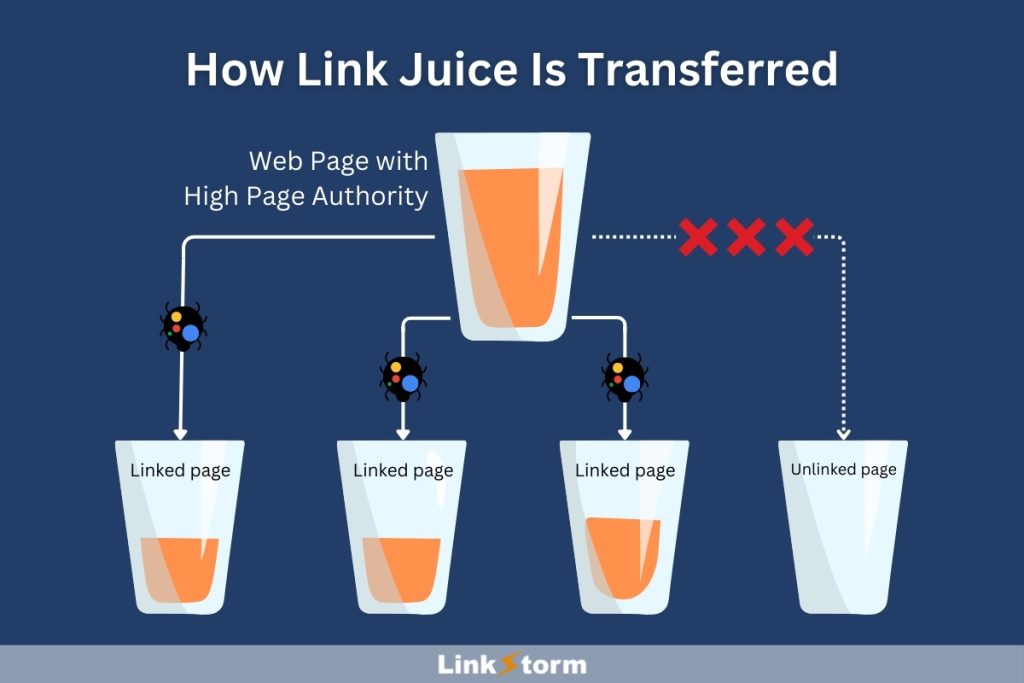
Strategic internal linking can help boost your page’s authority, improving SEO performance and ranking on search results pages.
This makes internal linking for SEO an integral component of your overall strategy.
Here are other benefits of internal linking that can positively impact SEO:
- Enhanced user experience: Internal links, especially contextual links, provide users with relevant content relative to their current search habits. This gives users more reason to spend time and explore your site, boosting SEO signals like dwell time and content quality.
- Stronger topical authority: Internal links are often used for building connections between pillar posts and topic clusters. Websites increase their topical authority by building a solid internal linking structure around pieces of content with related keywords. This puts websites ahead of others when users search for queries surrounding a particular topic. Our complete guide on internal linking is a perfectly good example of a pillar post branching out to cluster content.
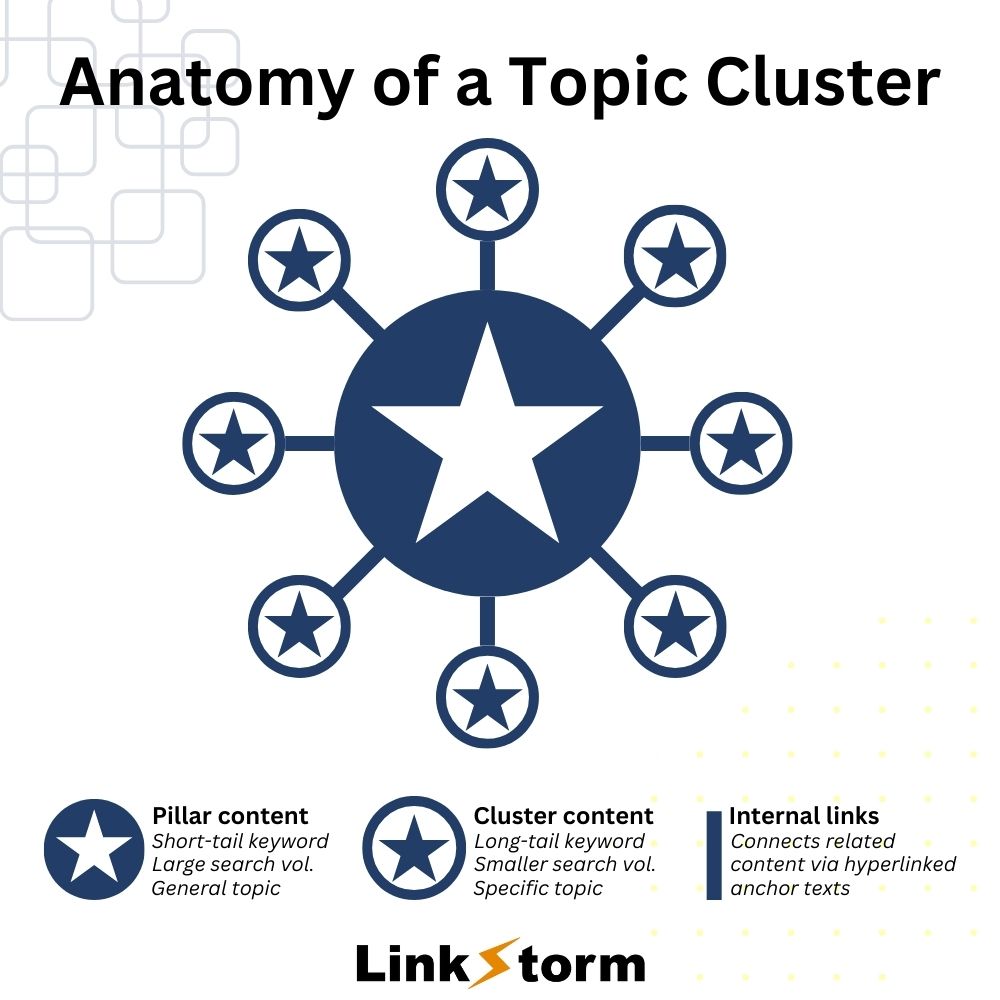
- Cost-effective: As opposed to building backlinks, internal linking is more affordable. For one, you are in charge of your internal linking efforts. There is no apparent need for a team or agency to perform that task. Equipped with the right tools, like LinkStorm, you can also expedite the process of building intelligent internal links.
The benefits of internal linking can never be understated. But before we look at the 7 strategies to bolster your internal linking, let’s first differentiate internal linking strategy vs best practices:
Internal Linking Strategy vs Best Practices: What’s the Difference?
Internal linking strategies are broad approaches that focus more on how to use internal links to achieve specific SEO goals. They involve planning and deciding where and how to use internal links to maximize their impact.
On the other hand, internal linking best practices are the technical and user-centric guidelines for implementing internal links effectively. They focus on the “how-to” aspects of internal linking, influencing the success rate of the initially set strategy.
In other words, if internal linking strategies are strategic and long-term, best practices are more tactical and short-term.
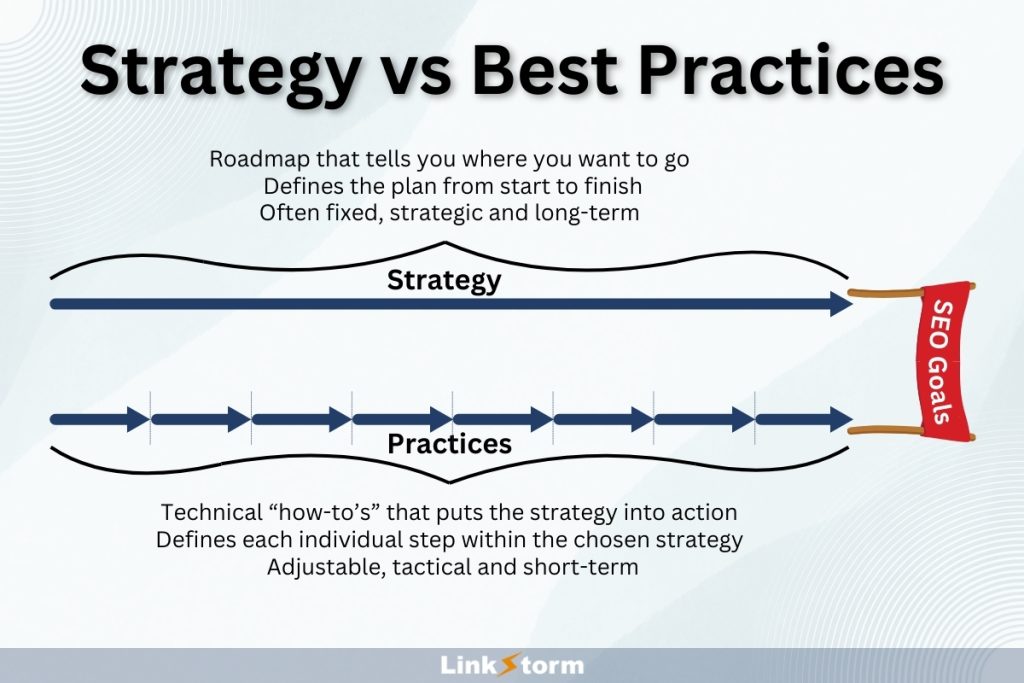
6 Internal Linking Strategies for Improved SEO
When done right, internal links are proven to boost your SEO. It’s important to create a strong internal linking strategy to ensure your site gets the most of your content and internal linking. Here are 7 internal linking strategies to take your SEO to the next level:
#1 Content Clusters and Pillar Pages
Content is the lifeline of all SEO efforts. All sites that include SEO among their marketing strategies will likely have content on their sites. Aside from being avenues for keyword research and targeting, content is also the breeding ground for both backlinks and internal links.
That is precisely the reason why managing your content is the first on the list of internal linking strategies.
Ideally, all the content on your website can be arranged strategically into a pyramid with the homepage at the tip, pillar pages in the middle, and cluster contents are the building blocks making up its structure:
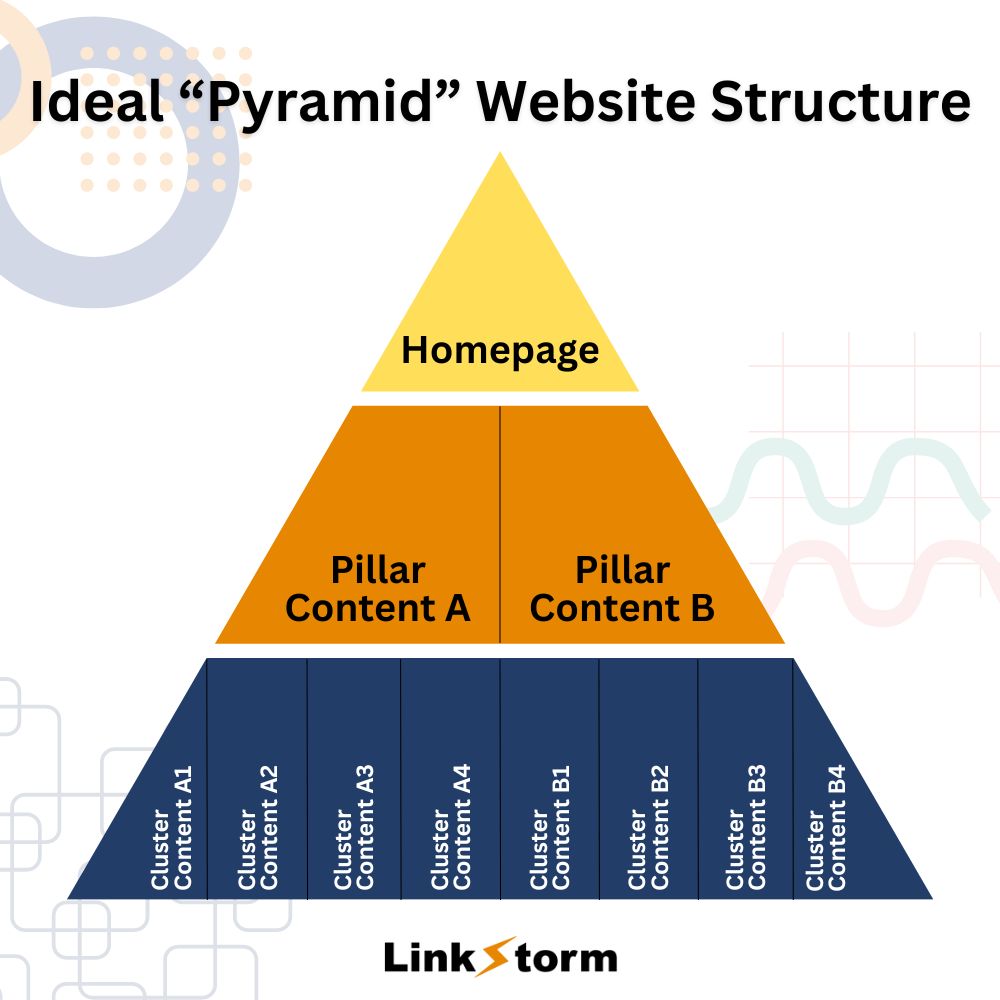
Now, you can approach this above information in two ways:
A. If there is no content on your site yet
If such is the case, you have the perfect starting point to plan out all the content you will produce.
Begin by brainstorming broad topics that are relevant to your niche. For instance, if you own a cat blog, you could create a pillar post on the keyword “best cats for first-time owners.” The key is focusing on short-tail keywords with high search volume and moderate competition.
After establishing your pillar post, you can now brainstorm cluster content that will surround the pillar topic. In the example above, you can write an owner’s manual for each cat listed on the pillar page.
For instance, “A Complete Guide to Owning a Maine Coon” or “Siamese Cats: Facts, Personality, & Care“. Repeat the process and you’ll have a content cluster that looks like this:
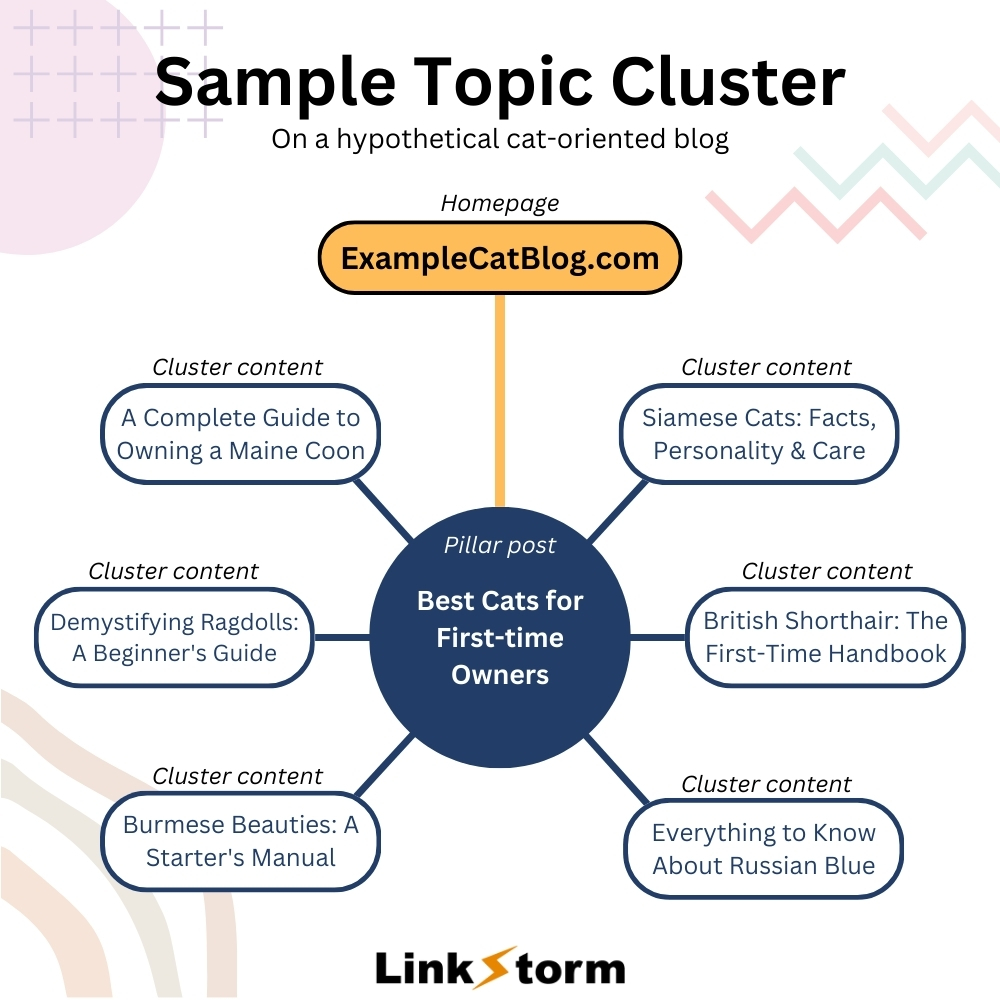
The pillar post should link to each of the cluster content. Also, find a way to link the cluster content back to the pillar page. Each cluster content must also interlink with each other to strengthen your topical authority. You may achieve this via contextual links, sidebar links, or other types of internal links.
B. If your site is filled with content already
This is the common starting point of many sites that want to take hold of their internal linking efforts. If this is you, there’s still a way to build many internal links that are intelligent and strategic.
First, create a database listing all your content. You can then manually go through each of your content that uses related keywords.
Conversely, you can use LinkStorm’s Pages tab to search for seed keywords instead. This reveals all the pages on your site that have the keyword in their URL or title tag. You can then use each category to arrange the results accordingly.
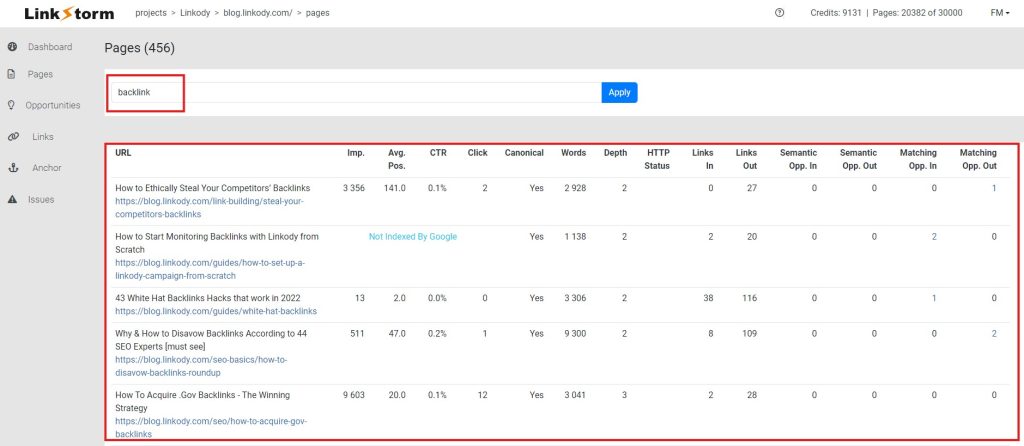
Once you have a list, you can then identify pages that can serve as your pillar posts and find pages that are pertinent cluster content around those pillar content. When you finish, you should have a collection of various cluster topics throughout your site.
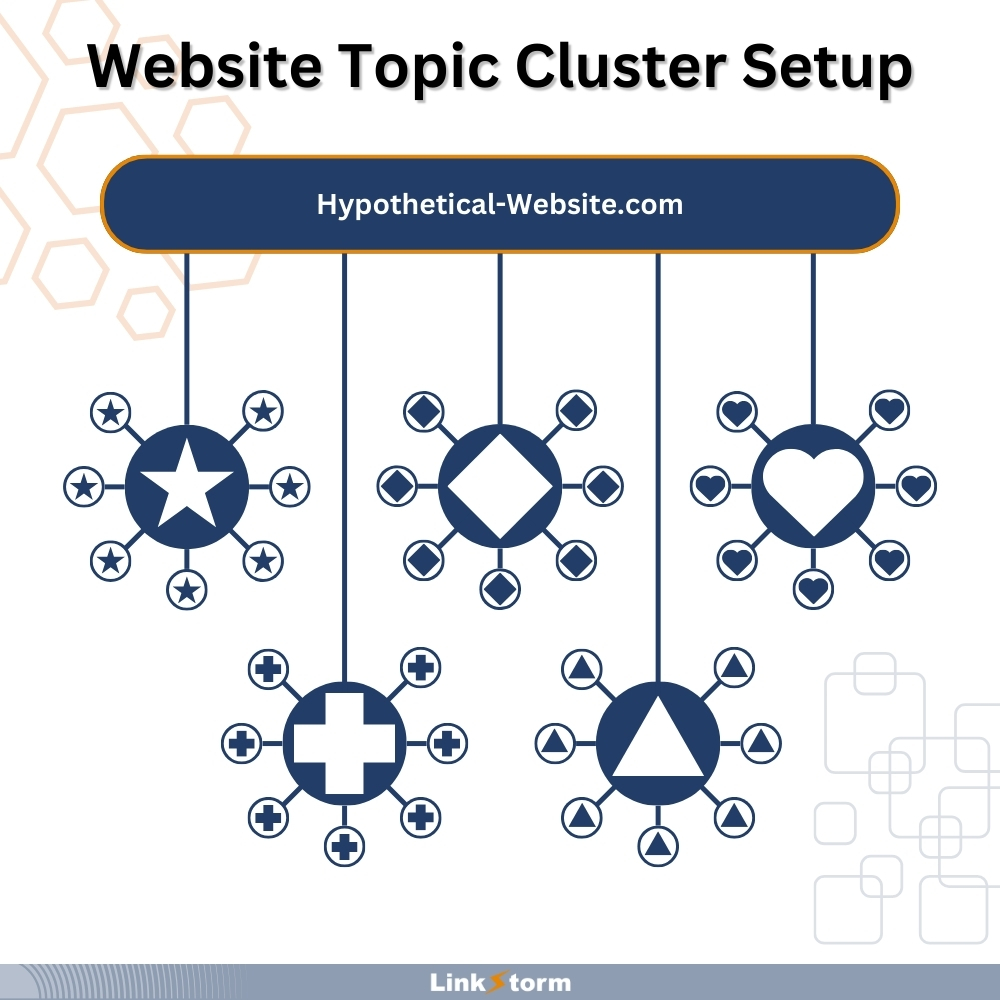
The next step is finding internal link opportunities from the pillar post to the cluster content and vice versa.
While you can perform this manually, LinkStorm expedites this process for a more seamless internal linking. Simply visit the opportunities tab and choose between which type of internal link opportunity you prefer:
- Semantic similarity: uses AI machine learning to find internal link opportunities based on semantic analysis
- Content matching: uses seed keywords throughout each content to find internal link opportunities
It’s best to explore both options for the best results.
From the internal link opportunities tab, you will find a search bar. Write the seed keyword of the pillar post on the first bar and the keyword of the cluster content on the second bar. This will reveal all possible internal linking opportunities from your pillar post to your cluster content.

You can then reverse the process to find internal linking opportunities from the cluster content back to your pillar post. Or input both cluster content keywords in the search boxes to interlink them with one another.
If no internal links are suggested between the pillar and cluster content, you will have to create a dedicated copy within the content to make way for internal linking opportunities.
#2 Target Long-tail Keywords
The usefulness of keyword research goes beyond content creation. You may also use a keyword as an anchor text for internal links.
Anchor text refers to the clickable text that users see when they encounter a hyperlink on a webpage. This text is typically highlighted or underlined to indicate that it leads to another page or resource. Aside from being placeholders for links, anchor texts serve as context providers of the internal pages they link to.
One common internal linking mistake among site owners is using generic phrases as anchors.
It’s crucial to use descriptive labels and optimize anchor texts to provide users with an idea of what they can expect once they click the link. Long-tail keywords help in this regard.
While short-tail keywords are fine, long-tail keywords are more specific and are composed of more words, literally. This gives you more headroom to capture the essence of the linked page to the given anchor.
(Note: If possible, anchor texts should be 5 words or less, a good combination of long-tail but straight to the point.)
The importance of targeting long-tail keywords for anchor texts can be summarized into three:
- The relevance of the linked page influences the amount of SEO value transferred from the source
- Descriptive long-tail anchors are more likely to be clicked than short-tail generic internal links
- You have a higher chance of including seed keywords using long-tail anchor texts
Given the purpose of internal links on a page is to prolong dwell time, meaningful anchor texts can help keep users glued to your website for longer.
Take a look at the example below:

Given the context of the surrounding words, one can deduce that the topic focuses on the importance of anchor texts in contextual links. Therefore, the internal link “anchor text best practices” aligns perfectly with the user’s search journey. Theoretically, this increases the likelihood of clicking the internal link indicated.
Sites using short-tail, generic, and non-descriptive anchor texts might miss out on valuable clicks and referral traffic. It’s important to take charge of your anchor texts to maximize their impact on your site.
LinkStorm can help put your anchor text usage into perspective. From the dashboard, just click on the Anchor tab to access all the anchor texts used in your site and see whether they are internal or external links.
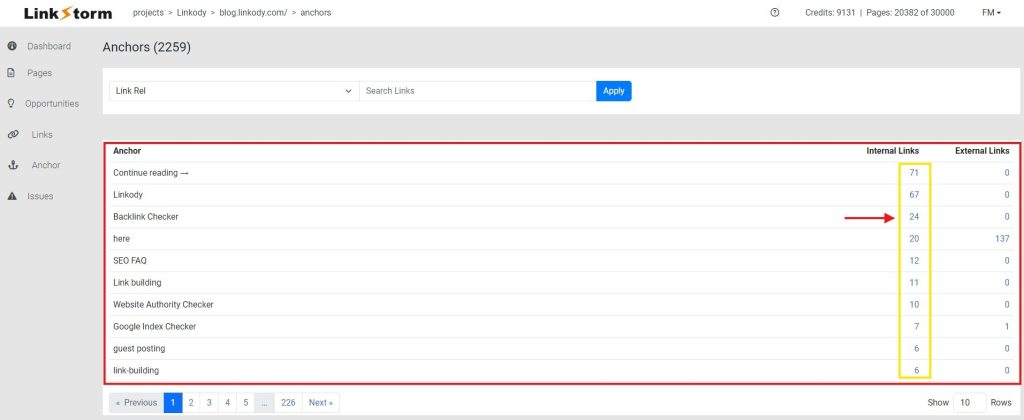
Clicking on any of the numbers will reveal the source and the linked page of the selected anchor text. With this, you can modify your anchor texts and diversify them accordingly to prevent web crawler confusion and ensure the optimum link value of your anchor texts.
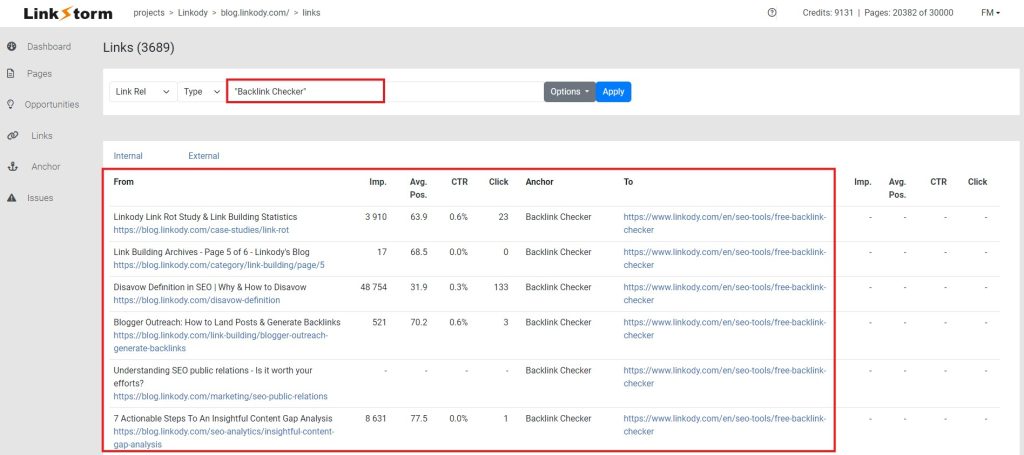
#3 Internal Link Reclamation
In a 7-year comprehensive study on backlinks, it was found that almost 50% of backlinks decay after 7 years. That means backlinks of websites actively engaged in link building will come from broken links, either due to domain expiration, URL changes, or modifications to the server architecture.
While that study focused on backlinks, the same can possibly be said for internal links. Every now and then, companies engage in website restructuring, and broken internal links may come as a consequence of these changes.
This is where internal link reclamation comes in.
Internal link reclamation is the process of finding problematic internal links within a website. Here are internal link issues that are resolved via link reclamation:
- Broken links: hyperlinks pointed to and from non-existent pages
- Inefficient links: internal links that aren’t passing link value as efficiently as they should
- Nofollow links: internal links that are mistakenly qualified with a nofollow attribute
- Noindex links: internal links coming from non-indexed pages
With LinkStorm’s issues tab, you can easily spot problematic hyperlinks that are plaguing your website. There you will find two types of issues: broken/redirected links and nofollow. Your goal is to eliminate all issues found on your internal links for maximum benefits.

As for ‘inefficient’ links, you will have to jump tabs from Issues to Opportunities.
The Opportunities tab features suggestions for internal linking along with other relevant information. Using the information on average positioning, you can strategize and direct your internal linking efforts accordingly.
You can do this in two ways:
- Scale-up approach: Build internal links from high-ranking pages to fellow high-ranking pages. Theoretically, this gives an additional boost to the SEO performance of pages already positively performing in SERPs.
- Scale-down approach: Create internal links from high-ranking pages to inferior-performing pages. This allows some page authority of high-ranking pages to transmit to the low-performing ones.
Below demonstrates the application of the scale-up and scale-down principle in action:

#4 Interlink New and Old Content
Click depth is a natural concept among websites. This refers to the number of clicks it takes for a user to reach a page from the homepage.
When content is consistently published throughout a domain, older content tends to be buried underneath a pile of new content. This increases the click depth of those links.
Naturally, the more click depth a page has, the more difficult it is for users to find and the less likely it is to be visited. Given the lack of search signals like page views, dwell time, and clicks, pages with higher click depth may tend to fall off SERP ranking.
Internal links are essential because they bridge the gap between old and new content on a website. Internal linking helps pages with high click depth restore their relevance by allowing users to revisit old material from newly published content.
LinkStorm allows for interlinking new and old content through its Opportunities tab. By deliberately creating internal links from low-click depth pages to high-click depth, you breathe new life into older content.
Potentially, this can enable old content to re-engage in the SERPs competition, provided they offer competitive and evergreen enough value.

#5 Internal Link Audits and Analysis
Internal linking is an indefinite affair. As long as your website exists and you continuously produce SEO content, internal linking will remain relevant. Each new page will have to be interconnected with existing pages throughout the website.
Since internal linking belongs to on-page SEO, this process is typically top-of-mind when creating content. However, we always have to take ‘human error’ into account, that is, the likelihood that we might overlook some pages when building internal links.
This is where internal link audits and analyses come in.
Internal link audit is the process of systematically evaluating the internal linking performance and structure of a website. It aims to identify opportunities to boost the flow of link equity and enhance user experience. It also uncovers constraints that limit websites from maximizing the benefits of internal linking.
Components of an internal linking audit
An internal link audit is achieved by analyzing 4 crucial pillars in your internal linking efforts. LinkStorm is an all-in-one tool you can use for auditing internal links, as explained below.
- [Missed] linking opportunities: LinkStorm’s Opportunities tab recommends internal link opportunities for you, whether through keyword matching or semantic analysis.
- Link relevance: LinkStorm’s Links tab lists all your interlinked pages including the anchor text used. This allows you to modify the anchor text to provide better context to the linked page.
- Anchor text usage: LinkStorm’s Anchor tab puts all your site’s anchor texts into perspective, so you may edit them accordingly by adding keywords and making them more descriptive.
- Internal linking issues: LinkStorm’s Issues tab reveals all the issues that disrupt your internal links, like broken links or redirects.
Ideal frequency of an internal link audit
The ideal frequency depends on the size and dynamism of your website. Here’s a breakdown:
- Small, static websites: Once a year might suffice, especially if content updates are infrequent.
- Medium-sized websites with moderate content updates: Consider audits every 6 months to catch any emerging issues.
- Large websites or those with frequent content updates: Aim for quarterly audits (every 3 months) to stay on top of changes and maintain a well-optimized structure.
Do keep in mind that the above recommendation is highly nuanced. For instance, conducting an audit right after a website redesign is recommended since a domain-wide structural rearrangement is often the direct consequence.
#6 Competitor Analysis
A successful internal linking strategy will not be complete without peeking into what your competitors are doing. A lot of internal links from rival websites can reveal so much information that goes beyond internal linking.
In highly cut-throat industries, many websites turn to SEO and content creation in hopes of one-uping their competitors. While this is beneficial initially, it exposes sites to strategic emulation, which is the process of replicating and improving their strategies.
If you explore the tools closely, you may find that LinkStorm also offers competitor analysis capabilities. LinkStorm comes integrated with spiders that can crawl and copy website content from websites. This grants you access to every link, anchor text, and page within their domain.
Since they are niche competitors, you are likely both ranking for the same keywords.
Using LinkStorm’s Pages tab, simply input your desired seed keyword into the search bar, and every page site-wide using that keyword will appear. This is a good benchmark for finding new content opportunities you haven’t covered on your site yet.
For example, for the keyword “backlink,” all the pages on Linkody using backlink as a seed keyword are revealed. Keep repeating the above process, experimenting with seed keywords until you find content gaps between your site and competitors.
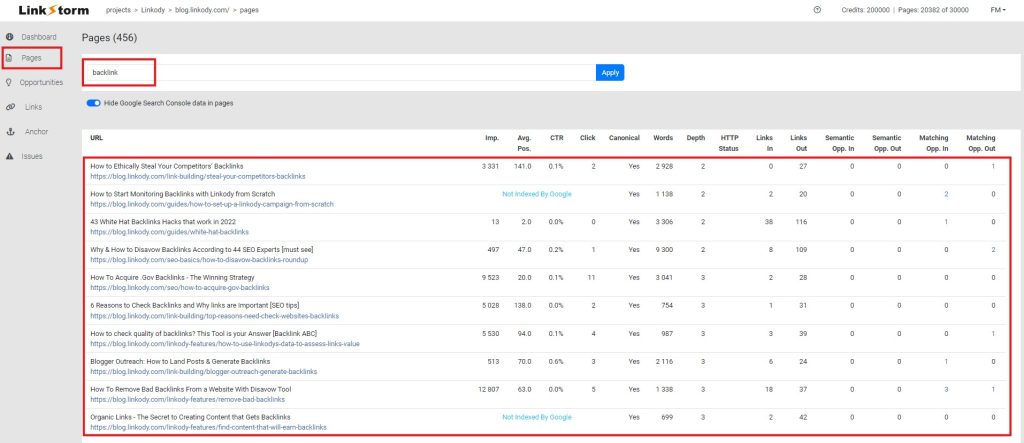
Aside from the Pages tab, you can also explore LinkStorm’s Links tab to find gaps in your content and internal linking.
Set the dropdown to ‘text’ and input your seed keyword in the search box. Following the initial example of “backlinks,” we will see all the internal links from pages ranking for the seed keyword to related pages.
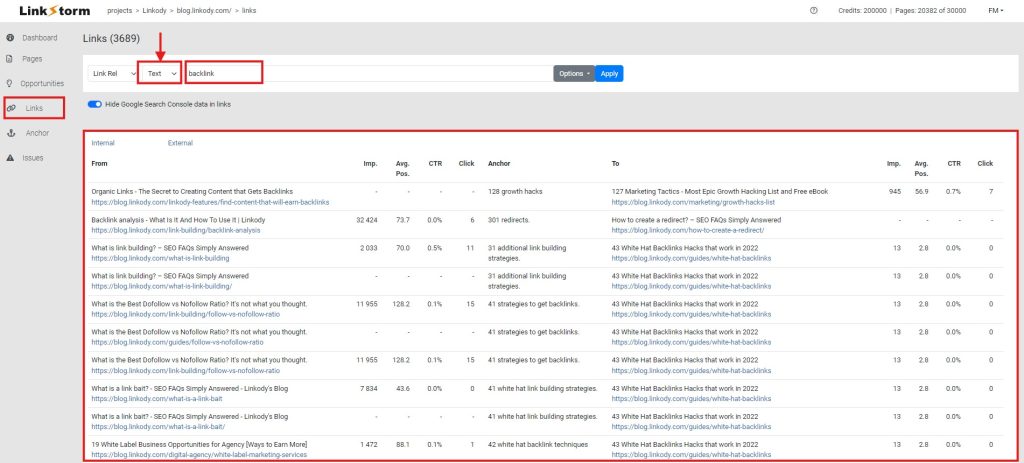
Using this information, you can find cluster content gaps throughout your website. Doing this will reveal if rivals are ranking for related or cluster content that you aren’t yet in your domain. This expands your cluster content pool and internal linking opportunities, making your site more topically authoritative versus competitors.
Moreover, the Link tab also demonstrates your competitors’ internal linking behavior. From the arrangement of results, you can deduce which is the pillar page and which is the cluster content. You will see how they interlink these pages and how they craft their anchor texts.
For example, a single anchor text is used for these three internal links. However, the anchor text used does not justify the context of the linked page, which may confuse the reader.
If you are a competitor ranking for the same content, you can use this information to make your anchor text more descriptive and keyword-rich.

Repeat this process with different keywords and various competitors for best results.
Plus, since LinkStorm is not a WordPress plugin, you can take full advantage of the tool to crawl any website. In other words, you can analyze any competitor and their respective internal linking strategies.
Need A Hand Implementing Your Internal Linking Strategies?
Internal links are more than just conduits of referral traffic. Internal links are important for improved search experience and are effective sources of link equity. However, the amount of PageRank your site gets depends heavily on the strategies employed.
Armed with the right tool coupled with proven tactics, you can streamline your processes and establish a solid internal linking strategy. LinkStorm is a powerful, all-in-one toolkit that can help elevate your internal linking efforts and your content creation program.
Need a hand implementing your internal linking strategies?
LinkStorm is here to help.
Discover which pricing plan best suits your internal linking needs here.
Happy linking!
Leave a Reply